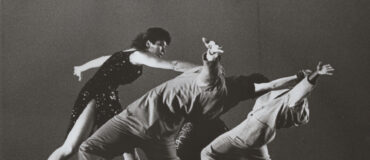By Daina Coffey
Daina Coffey is Dance/USA’s second Dance Archiving & Preservation Fellow. Her Fellowship, which ran from August-December 2018, was hosted by the Chicago Dance History Project, and her practicum site was Joel Hall Dancers. Read more about the Fellowship program here and read her first, second, and third blog posts.
January 22, 2019: The Chicago Dance History Project
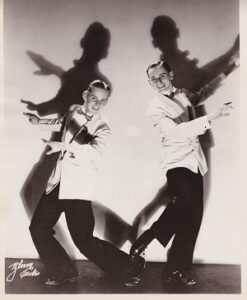
Charles Grass and Bob Fosse perform as the dance team, “The Riff Brothers,” ca 1940s.
When I started as the Dance Archiving and Preservation Fellow this past fall at the Chicago Dance History Project (CDHP), I wasn’t entirely sure what to expect. I had worked before at various institutions such as the Bancroft Library at U.C. Berkeley and the Seaver Center for Western History Research at the Natural History Museum of Los Angeles, and I had been accustomed to reporting to a collections manager who gave me a list of archival tasks to complete.
CDHP proved to be an entirely different experience. Much to my delight, I was thrown into the deep-end of dance exhibits and archives, and while I was given all the support I needed, I was also given space to think critically and creatively.
CDHP is an organization run by dancers, and it shows. It’s small, it’s scrappy, and it’s unique. The goal of CDHP is, in their words, to “investigate, preserve, and present the oral and corporeal histories of theatrical dance in Chicago and its vicinity.” Headed by the indefatigable Jenai Cutcher, Executive Director and tap-dancer extraordinaire, CDHP has helped uncover many lesser-known members of the thriving Chicago historical dance community. In conducting scores of oral history interviews and digitizing materials held in personal as well as small dance studio collections, CDHP is in the process of creating an exceptional archive.
As I covered in my previous blog posts, one of my first tasks at CDHP was to create an exhibit for the Joel Hall Dancers and Center’s (JHDC) “Legacy Concert.” This was an eye-opening and highly educational experience for me—curating a physical exhibit from start to finish. However, once I completed that project, my next task was to figure out how to organize some of CDHP’s digital collections.
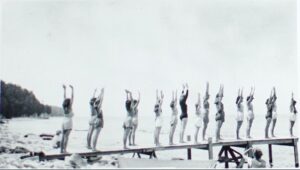
Young dancers do warm-up exercises on the docks at the Mabel Katherine Pearse Modern Dance Camp on Washington Island in the early 1940s.
This included not only the JHDC Collection but the Charles Grass Collection (Grass teamed with Bob Fosse in the 1940s in a dance duo, “The Riff Brothers”) and the Mabel Katherine Pearse Modern Dance Camp Collection (this includes two scrapbooks filled with young dance student Mary Kay Lackritz Gray’s memories of her time at the Mabel Katherine Pearse Modern Dance Camp in the early 1940s), among several others.
I thus transitioned from the glitz and glamour of the exhibit world to the more solitary but still rewarding world of putting thousands of digital files into something resembling order. I examined every photograph, video, letter, contract, script, and piece of choreographic notes in each collection, wrote descriptions, determined date ranges, and attempted to place everything in some sort of logical order with a consistent file naming method.
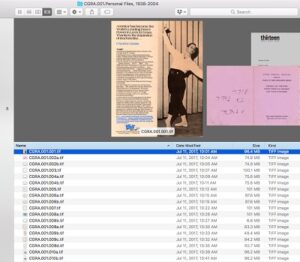
Example of file organization from the Charles Grass Collection
A time-consuming task to be sure, but this is the crucial work that makes archival preservation possible. A dance collection is of little use if you can’t find anything, and organizing and documenting this material makes it easier to track. And, as I’ve learned over the past few months, dancers and dance companies rely on their archives. They serve as not only a means of preserving one’s legacy, but also as a constant source of memory, inspiration, and renewal.
As my fellowship draws to a close, I am so grateful to Dance/USA and the Chicago Dance History Project—especially to Imogen Smith and Jenai Cutcher—for this incredible opportunity to work the field of dance archives. I cannot begin to share how much I’ve learned and grown over these past few months, and I am forever honored by the chance to preserve and promote the incredible work of Chicago’s historical dance community.
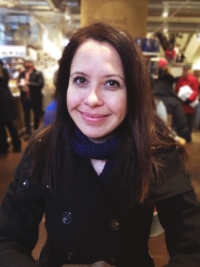 Daina Coffey is a Ph.D. Candidate studying U.S. history at the University of Chicago, where her teaching and research focuses on race, gender, and capitalism as well as urban and legal history. Deeply interested in digital preservation and records management, issues of accessibility, and curatorial practices, she has worked at a number of archives including the Bancroft Library at U.C. Berkeley, the Seaver Center for Western History Research at the Natural History Museum of Los Angeles, and the Special Collections and Research Center at the University of Chicago. Daina is thrilled to develop her archival skill set through working with local artists and dance-legacy materials at the Chicago Dance History Project this fall.
Daina Coffey is a Ph.D. Candidate studying U.S. history at the University of Chicago, where her teaching and research focuses on race, gender, and capitalism as well as urban and legal history. Deeply interested in digital preservation and records management, issues of accessibility, and curatorial practices, she has worked at a number of archives including the Bancroft Library at U.C. Berkeley, the Seaver Center for Western History Research at the Natural History Museum of Los Angeles, and the Special Collections and Research Center at the University of Chicago. Daina is thrilled to develop her archival skill set through working with local artists and dance-legacy materials at the Chicago Dance History Project this fall.
____
We accept submissions on topics relevant to the field: advocacy, artistic issues, arts policy, community building, development, employment, engagement, touring, and other topics that deal with the business of dance. We cannot publish criticism, single-company season announcements, and single-company or single artist profiles. Additionally, we welcome feedback on articles. If you have a topic that you would like to see addressed or feedback, please contact communications@danceusa.org.
Disclaimer: Opinions expressed in guest posts do not necessarily represent the viewpoints of Dance/USA.

